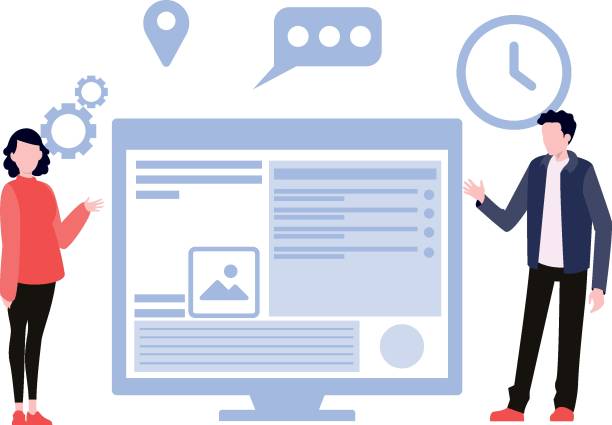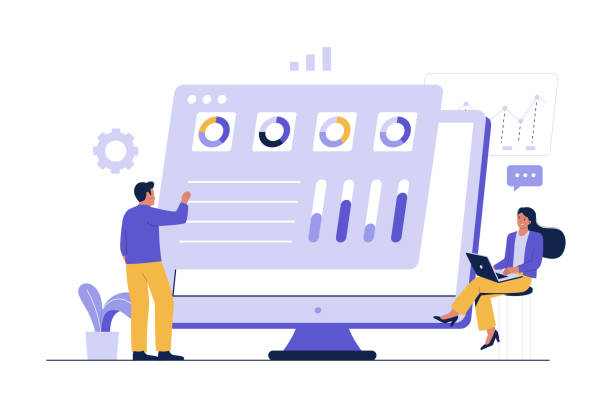An Introduction to the Importance of Modern UI Website Design in the Digital Age

In today’s fast-paced world, where digital competition is at its peak, modern UI website design is no longer a luxury choice but a fundamental necessity for the survival and success of businesses.
This approach means creating websites that are not only visually appealing but also provide an unparalleled and seamless user experience (UX) for visitors.
In fact, #website_design with superior #user_interface and #user_experience is your winning card in attracting and retaining an audience.
Old websites lacking modern design are not only unable to satisfy new generation users but also lose a significant portion of their traffic due to lack of optimization for various devices.
This transformation can be considered a major leap in the web design industry.
Have you ever wondered why some websites keep you engaged for hours, while others tire and bore you in just a few seconds? The answer lies in the quality of User Interface (UI) design and User Experience (UX).
Modern UI website design is based on the principles of user psychology, simplicity, accessibility, and responsiveness.
This analytical approach views and optimizes the website from the end-user’s perspective, ensuring every visitor enjoys a pleasant and efficient journey.
This is not just a technical discussion, but an important educational and explanatory topic for any business wanting to shine in the online space.
Do you have an e-commerce website, but your sales aren’t as expected? Rasaweb solves your problem forever with professional e-commerce website designs!
✅ Significant increase in conversion rates and sales
✅ Unparalleled user experience for your customers
⚡ Click here to get a free consultation with Rasaweb!
Fundamental Principles of Modern UI/UX Design

Modern UI website design is built upon a set of fundamental principles whose ultimate goal is to create an exceptional user experience.
Simplicity is one of the most important of these principles.
The design should be so transparent and uncomplicated that the user reaches their goal without any confusion.
Removing superfluous elements and visual clutter significantly helps increase user focus and reduce the time to achieve a goal.
The second principle is responsiveness (Responsive Design).
Given the incredible variety of devices users employ for browsing, from small mobile phones to large desktop monitors, the website must intelligently adapt to the screen dimensions and resolution.
This technical guidance ensures that the user experience is consistent and optimized on every device.
Accessibility is another principle, meaning designing websites for all users, including people with disabilities.
This includes using appropriate color contrast, alternative text for images (alt text), and a correct semantic HTML code structure.
This specialized approach demonstrates a commitment to inclusivity and ethics in design.
Finally, consistency and coherence in design are crucial.
Navigation elements, fonts, colors, and icons should be consistent across the entire website so that the user feels familiar and comfortable and can easily discern their path.
Adhering to these principles in website design with a modern user experience not only enhances the website’s aesthetic appeal but also directly impacts its effectiveness and success.
User Research and Its Role in Modern UI Website Design

Before embarking on any modern UI website design, the essential step is to conduct comprehensive and precise research on the target users.
This educational and analytical phase is the cornerstone of any successful design; without a deep understanding of users’ needs, behaviors, motivations, and pain points, the design, no matter how beautiful, cannot be effective.
Creating User Personas, which are fictional representations of real users, is one of the most powerful tools in this phase.
These personas help designers empathize with their users and make design decisions based on their actual needs.
Interviews, surveys, focus groups, and behavioral data analysis (such as heatmaps and user session recordings) are among the common methods in user research.
This data allows the design team to confirm or refute their initial assumptions and lay an evidence-based path for modern UI website design.
Any questionable content in the design can be identified and resolved through initial user research.
In fact, investing in this stage means saving time and money in subsequent stages and ensuring a final output that truly addresses the audience’s needs.
Below is a simple table of user research methods:
| Research Method | Description | Primary Use |
|---|---|---|
| User Interviews | In-depth, face-to-face conversations with users to understand needs and motivations. | Identifying qualitative needs and hidden insights. |
| Surveys | Collecting quantitative data from a large number of users. | Identifying statistical patterns and trends. |
| Usability Testing | Observing users while they interact with a prototype or final product. | Identifying usability issues and friction points. |
| Competitor Analysis | Reviewing and evaluating competitor websites to identify strengths and weaknesses. | Understanding competitive position and opportunities for improvement. |
Visual and Aesthetic Trends in Modern UI Website Design

The visual aspect of modern UI website design is the beating heart of aesthetics and appeal.
Visual design trends are constantly changing and evolving, and keeping up with them is essential to maintain a website’s freshness and appeal.
One of the most prominent current trends is minimalism.
This style emphasizes simplicity, ample white space, and the removal of unnecessary elements to highlight content and allow the user to focus on what truly matters.
Dark Mode design has also become very popular due to reduced eye strain and a sleek, modern appearance.
This trend is not only an entertaining feature but also helps increase accessibility in low-light environments.
Using high-quality, full-screen images and videos, along with subtle animations and Micro-interactions, can elevate the user experience to a new level.
These small micro-interactions, such as a button changing color upon click or displaying an attractive loading animation, provide feedback to the user and create a sense of dynamism and responsiveness.
Typography plays a vital role in readability and aesthetics; choosing appropriate fonts and a strong visual hierarchy can clearly convey the website’s message.
Combining bold colors and appealing color palettes can also make a website stand out.
Ultimately, focusing on modern UI website design means creating a pleasant visual experience that not only attracts the user but also encourages them to explore the website further, conveying a message of your brand’s professionalism and up-to-dateness.
This news-oriented approach showcases the latest developments.
Did you know that 94% of users’ first impressions of a business are related to its website design? With professional corporate website design by **Rasaweb**, transform this first impression into an opportunity for growth.
✅ Attract more customers and increase sales
✅ Build credibility and trust in the audience’s eyes⚡ Get a free website design consultation!
Technical Aspects and Optimization in Modern UI Website Design

Beyond aesthetics, modern UI website design requires special attention to technical aspects and performance optimization.
A beautiful but slow and unresponsive website quickly disappoints users.
Page loading speed is one of the most critical technical factors that directly impacts both user experience and SEO.
Image optimization, code compression (CSS, JavaScript, HTML), and using Content Delivery Networks (CDNs) are among the measures that help improve loading speed.
Building a website with an advanced user interface also requires adherence to clean and optimized coding standards.
Using appropriate APIs for integration with external services and ensuring website security through SSL certificates and adherence to security protocols are other specialized requirements.
Responsiveness (Responsive Design), mentioned earlier, is a critical technical aspect achieved through the use of CSS Media Queries and Mobile-First design approaches.
This is an important explanation to ensure website accessibility across any device.
Finally, continuous guidance and monitoring of website performance with tools like Google PageSpeed Insights and Google Analytics to identify bottlenecks and opportunities for improvement is an integral part of the modern UI website design lifecycle.
Search Engine Optimization (SEO), which requires adherence to technical and content principles, must also be considered from the very initial design stages so that the website can be easily discovered by search engines.
The Impact of AI and Personalization in Modern UI Website Design

Is Artificial Intelligence poised to revolutionize the future of modern UI website design? This is a thought-provoking yet highly crucial question.
Artificial Intelligence (AI) and Machine Learning (ML) are transforming the landscape of UI/UX design, enabling unprecedented personalization.
Using AI algorithms, websites can analyze user behavior and dynamically adjust content, recommendations, and even UI layouts based on each user’s individual preferences.
This level of personalization significantly enhances the user experience and creates a deeper sense of connection and understanding between the user and the website.
For instance, an e-commerce website can suggest products that are more likely to interest the user based on their purchase and search history.
AI-powered chatbots improve customer support and quickly answer user questions, which in turn contributes to modern UI website design.
AI-driven design tools are also emerging that can assist designers in automating repetitive tasks, generating initial layouts, and even optimizing layouts based on user data.
These advancements enable the creation of websites that are not only responsive but also actively interact with users and adapt to their needs.
This analysis of the future indicates that modern UI website design is moving towards an intelligent and dynamic system where every interaction leads to a unique and optimized experience.
Tools and Technologies Used in Modern UI Website Design

For the successful implementation of modern UI website design, familiarity with and mastery of a set of specialized tools and technologies are essential.
These tools help designers and developers streamline the design and implementation process more efficiently and effectively.
In the design and prototyping phase, tools such as Figma, Adobe XD, Sketch, and InVision are among the most popular options.
These platforms enable UI design, wireframe creation, interactive prototype building, and team collaboration.
Figma has rapidly gained popularity due to its cloud collaboration capabilities and real-time co-design features.
For the front-end development, responsible for implementing the visual and interactive parts of the website, a set of languages and frameworks are used.
HTML5 for content structure, CSS3 for styling, and JavaScript for adding dynamic interactions, form the foundations of this section.
JavaScript frameworks like React, Angular, and Vue.js are also widely used for building complex and Single-Page Applications (SPA) user interfaces.
These tools and technologies enable modern and powerful UI web development.
For content management, Content Management Systems (CMS) like WordPress, Drupal, and Joomla are highly popular, while for larger and more customized projects, back-end frameworks like Node.js, Django (Python), and Ruby on Rails are employed.
Below is a table of the most commonly used UI/UX design tools:
| Category | Tool/Technology | Primary Use |
|---|---|---|
| Design & Prototyping Tools | Figma, Adobe XD, Sketch | UI Design, Wireframing, Prototyping, Collaboration |
| Front-end Frameworks | React, Angular, Vue.js | Building Interactive User Interfaces and Single Page Applications (SPA) |
| Content Management Systems (CMS) | WordPress, Drupal, Joomla | Easy Website Content Management |
| Back-end Programming Languages | Node.js, Python (Django), Ruby on Rails | Database Management, Server Logic, and APIs |
Measuring the Success of Modern UI Website Design

After implementing modern UI website design, the work is not over; rather, a crucial phase of measuring and evaluating success begins.
Without quantitative and qualitative data, it’s impossible to definitively state what impact the new design has had on users and business objectives.
Web analytics tools like Google Analytics and Hotjar provide valuable information about user behavior, navigation paths, bounce rate, time on site, and conversion rate.
This analytical data reveals the strengths and weaknesses of the design and helps identify areas that need improvement.
A/B testing is a powerful method for comparing two different versions of a page or design element to determine which performs better.
For example, two different designs for a Call-to-Action button can be shown to different user groups, and their click-through rates can be compared.
This is practical guidance for continuous optimization.
Collecting direct feedback from users through surveys, feedback forms, and interviews is also of high importance.
These explanatory and qualitative feedbacks provide deep insights into users’ perceptions and feelings towards the website.
Ultimately, the success of modern UI website design is measured by continuous improvement and iteration based on data and feedback.
This is a continuous cycle of design, implementation, measurement, and optimization that keeps the website on a path of growth and efficiency.
Are you tired of losing business opportunities due to lacking a professional corporate website?
Rasaweb, with its professional corporate website design, helps you:
✅ Build a powerful and reliable image for your brand
✅ Convert website visitors into loyal customers
⚡ Get a free consultation now!
Challenges and the Future of Modern UI Website Design

Although modern UI website design offers countless advantages, it also comes with challenges that need to be addressed.
One of the biggest challenges is keeping pace with rapid technological changes and design trends.
What is considered modern and advanced today might seem outdated tomorrow.
This necessitates continuous learning and updating knowledge and skills.
Another challenge is ensuring accessibility for all users, including people with disabilities.
This issue is not only an ethical imperative but also a legal requirement in many countries.
Security and user data privacy are also major concerns in modern UI website design, especially with the increased use of personal data for personalization.
Can the user experience be optimized without violating user privacy? This is a thought-provoking question that designers must answer.
The future of modern UI website design is moving towards more immersive and integrated experiences.
Augmented Reality (AR) and Virtual Reality (VR) hold great potential to change how we interact with websites, which itself could be big news in this field.
Voice User Interfaces (VUIs) are also growing with the expansion of voice assistants like Siri and Google Assistant, and will soon become an integral part of the web experience.
In the future, modern UI website design will extend beyond web pages to become digital ecosystems where integrated and intelligent interactions occur across various platforms and devices.
This is a specialized and news-oriented outlook on the future.
The Importance of Investing in Modern UI Website Design for Businesses

Investing in modern UI website design is no longer an extra expense but a vital investment with a high Return on Investment (ROI) for any business aiming to remain competitive in the digital age.
A website with modern design and an optimized user experience directly impacts increased conversion rates, reduced bounce rates, and enhanced customer satisfaction.
Today’s users have high expectations for websites; they seek speed, simplicity, aesthetics, and a personalized experience.
A website that fails to meet these expectations quickly drives potential customers towards competitors.
Modern design also helps strengthen the brand and create a professional and trustworthy image for the business.
A well-designed and up-to-date website reflects the business’s attention to detail and respect for its audience.
This modern UI website design helps businesses stand out in today’s crowded market.
From an SEO perspective, websites with responsive design and high loading speed perform better in search engine rankings, which means increased visibility and attracting more organic traffic.
Ultimately, a user-friendly website helps reduce customer support costs, as users can easily find the information they need and complete their tasks without requiring assistance.
This is a key guidance for long-term success.
Therefore, investing in modern UI website design is not merely an aesthetic explanation but a smart and essential business strategy.
Frequently Asked Questions
| Question | Answer |
|---|---|
| What is modern UI website design? | An approach to website design that focuses on clean aesthetics, simplicity, high usability, and providing a visually appealing and pleasant user experience (UX). |
| What are the key elements of a modern web UI? | Flat Design, intelligent use of white space, attractive typography, intuitive navigation, high-quality images, and responsiveness are key elements. |
| Why is using a modern UI in website design important? | It attracts and retains users, boosts brand credibility, improves conversion rates, and provides a smooth and pleasant user experience. |
| How does modern User Interface (UI) affect User Experience (UX)? | Modern UI directly improves UX by creating a beautiful, organized, and understandable environment, making interaction easier. |
| What is the role of typography in modern UI design? | Typography is crucial for readability, creating information hierarchy, conveying brand mood, and the overall visual appeal of the site. |
| How is Responsive Design related to modern UI? | Responsive design is an integral part of modern UI because it ensures the site’s appearance and functionality are consistent and optimal across all devices (mobile, tablet, desktop). |
| What are the current trends in modern web UI design? | Dark Mode, subtle animations, creative use of white space, prominent typography, and the use of asymmetrical graphic elements are among the recent trends. |
| How can one ensure a modern UI has high usability? | By conducting user testing, simplifying navigation, providing clear Calls-to-Action (CTAs), improving loading speed, and focusing on Accessibility. |
| What is the main difference between UI and UX in modern design? | UI is the look and feel of the site (user interface), while UX is the overall experience of the user when interacting with the site. UI is considered a part of UX. |
| What tools are used for modern web UI design? | Common tools like Figma, Sketch, Adobe XD, Photoshop, and Illustrator are used for modern UI design and prototyping. |
And other advertising services by Rasaweb Advertising Agency:
Smart Conversion Rate Optimization: A dedicated service for growth in website traffic based on custom programming.
Smart Marketing Automation: An effective tool for user engagement with precise audience targeting.
Smart UI/UX: A new service for increasing online growth through SEO-driven content strategy.
Smart Digital Advertising: An effective tool for online growth by optimizing key pages.
Smart Data Analysis: A fast and efficient solution for increasing click-through rates with a focus on custom programming.
And over a hundred other services in the field of internet advertising, advertising consultation, and organizational solutions.
Internet Advertising | Advertising Strategy | Advertorials
Resources
UI/UX Design Principles for Websites
Recent Website Design Trends
What is Digital Transformation?
The Future of Web Design
? Rasaweb Afarin, by providing comprehensive digital marketing services, from multilingual website design and SEO to content marketing and social media, guides your business to new horizons of success. Contact us for consultation and to enhance your online presence.
📍 Tehran, Mirdamad Street, next to Bank Markazi, Southern Kazeroun Alley, Ramin Alley, No. 6

